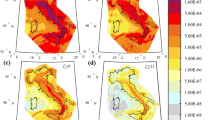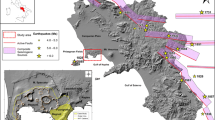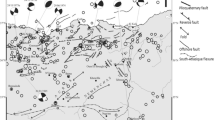Abstract
In many countries such as Spain earthquake databases still mainly comprise macroseismic data from felt effects. The full exploit of this information is of basic importance for seismic risk assessment and emergency planning, given the strict link between macroseismic intensity and damage. A probabilistic procedure specifically developed to handle macroseismic data, mostly relying on site information and seismogenic-source free, has been applied to evaluate seismic hazard in SE-Spain (Alicante-Murcia region). Present seismicity is moderate-low with largest magnitudes slightly over Mw5.0. The historical record includes very destructive earthquakes, maximum EMS98 intensities reaching IX–X and X in the nineteenth century (e.g., Torrevieja 1829 earthquake). Very recently, two events in the area on 11 May 2011 (Mw4.5, Mw5.2) killed nine people, injured 300, and produced important damage in the city of Lorca. Regional hazard maps for the area together with specific hazard curves at selected localities are obtained. Results are compared with the maximum observed intensities in the period 1300–2012, and with the values in the seismic hazard map from the Spanish Building Code in force. In general, the maximum felt intensity values are closer to the hazard values calculated for 2 % probability of exceedance in 50 years, using felt and expected intensity. The intensity-based probabilistic hazard maps obtained through the applied approach reduce the inherent smoothing of those based on standard probabilistic seismic hazard assessment approaches for the region, allowing identifying possible over- or sub-estimates of site hazard values, providing very valuable information for risk reduction strategies or for future updates of the building code hazard maps.











Similar content being viewed by others
References
Albarello D (2012) Design earthquake from site-oriented macroseismic hazard estimates. Boll Geofis Teor Appl 53(1):7–17
Albarello D, D’Amico V (2004) Attenuation relationship of macroseismic intensity in Italy for probabilistic seismic hazard assessment. Boll Geofis Teor Appl 45(4):271–284
Albarello D, Mucciarelli M (2002) Seismic hazard estimates from ill-defined macroseismic data at a site. Pure Appl Geophys 159(6):1289–1304
Albarello D, Bramerini F, D’Amico V, Lucantoni A, Naso G (2002) Italian intensity hazard maps: a comparison between results from different methodologies. Boll Geofis Teor Appl 43:249–262
Albini P, Rodriguez de la Torre F (2001) The 1828–1829 earthquake sequence in the provinces of Alicante and Murcia (S-E Spain): historical sources and macroseismic intensity assessment. In: Glade T et al (eds) The use of historical data in natural hazard assessments, advances in natural and technological hazards research, vol 17. Springer, Berlin, pp 35–53
Azzaro R, Barbano MS, D’Amico S, Tuvè T, Albarello D, D’Amico V (2008) Preliminary results of probabilistic seismic hazard assessment in the volcanic region of Mt. Etna (Southern Italy). Boll Geofis Teor Appl 49(1):77–91
Benito B, Capote R, Murphy P, Gaspar-Escribano JM, Martínez-Díaz JJ, Tsige M, Stich D, García-Mayordomo J, García-Rodríguez MJ, Jiménez ME, Insúa-Arévalo JM, Alvarez-Gómez JA, Canora C (2007) An overview of the damaging and low magnitude Mw 4.8 La Paca earthquake on 29 January 2005: context seismotectonics and seismic risk implications for Southeast Spain. Bull Seismol Soc Am 97(3):671–690
Bindi D, Abdrakhmatov K, Parolai S, Mucciarelli M, Grunthal G, Ischuk A, Mikhailova N, Zschau J (2012) Seismic hazard assessment in Central Asia: outcomes from a site approach. Soil Dyn Earthq Eng 37:84–91
Buforn E, Benito B, Sanz de Galdeano C, del Fresno C, Muñoz D, Rodriguez I (2005) Study of the damaging earthquakes of 1911, 1999, and 2002 in the Murcia, Southeastern Spain, region: seismotectonic and seismic-risk implications. Bull Seismol Soc Am 95(2):549–567
Cornell CA (1968) Engineering seismic risk analysis. Bull Seismol Soc Am 58:1583–1606
D’Amico V, Albarello D (2003) The role of data processing and uncertainty management in seismic hazard evaluations: insights from estimates in the Garfagnana-Lunigiana Area (Northern Italy). Nat Hazard 29:77–95
D’Amico V, Albarello D (2008) SASHA: a computer program to assess seismic hazard from intensity data. Seismol Res Lett 79(5):663–671
Galea P (2007) Seismic history of the Maltese islands and considerations on seismic risk. Ann Geophys 50(6):725–740
García-Fernández M, Jiménez MJ (2012) Site characterization in the Vega Baja, SE Spain, using ambient-noise H/V analysis. Bull Earthq Eng 10(4):1163–1191
Grünthal G (Ed.) (1998) European Macroseismic Scale 1998 (EMS-98). European Seismological Commission, Working Group Macroseismic Scale, Cahiers du Centre Européen de Géodynamique et de Séismologie 15, Luxembourg
IGME (2012) QAFI: Quaternary Active Faults Database of Iberia. www.igme.es/infoigme/aplicaciones/QAFI/. Accessed 25 May 2013
Jiménez MJ, Giardini D, Grünthal G (eds.) (2003) European-Mediterranean Seismic Hazard Map, 1:5.000.000. European Seismological Commission
Jiménez MJ, García-Fernández M, Beltrán A, Teves-Costa P, Batlló J (2015) Maximum seismic intensities in Iberia in the 1300–2012 record. Seismol Res Lett (submitted)
Martínez-Díaz JJ, Bejar-PizarroM Álvarez-Gómez JA, Mancilla F, Stich D, Herrera G, Morales J (2012) Tectonic and seismic implications of an intersegment rupture. The damaging May 11th 2011 Mw 5.2 Lorca, Spain, earthquake. Tectonophysics 546–547:28–37
Martinez Solares JM and Mezcua J (2002) Catálogo sísmico de la Península Ibérica (880 a.C.—1900). Monograph no 18, Instituto Geográfico Nacional, Pub. 303, Madrid (in Spanish)
Martínez Solares JM, Cabañas L, Benito MB, Rivas A, Gaspar JM, Ruíz S, Rodríguez O (2013) Actualización de mapas de peligrosidad sísmica de España 2012. CNIG, Instituto Geográfico Nacional, Madrid (in Spanish)
McGuire RK (1978) FRISK: Computer program for seismic risk analysis using faults as earthquake sources, USGS Open File Report 78-1007
Musson R, Grünthal G, Stucchi M (2010) The comparison of macroseismic intensity scales. J Seismol 14(2):413–428
NCSE-02 (2003) Norma de Construcción Sismorresistente: Parte general y edificación (NCSE-02). Instituto Geográfico Nacional, Ministerio de Fomento, Madrid
Pasolini C, Albarello D, Gasperini P, D’Amico V, Lolli B (2008) The attenuation of seismic intensity in Italy part II: modelling and validation. Bull Seismol Soc Am 98(2):692–708
Rotondi R, Zonno G (2004) Bayesian analysis of a probability distribution for local intensity attenuation. Ann Geophys 47(5):1521–1540
Rotondi R, Varini E, Brambilla C (2015) Probabilistic modelling of macroseismic attenuation and forecast of damage scenarios. Bull Earthq Eng. doi:10.1007/s10518-015-9781-7
Wessel P, Smith WHF, Scharroo R, Luis JF, Wobbe F (2013) Generic mapping tools: improved version released. EOS Trans AGU 94:409–410
Zonno G, Rotondi R, Brambilla C (2009) Mining macroseismic fields to estimate the probability distribution of the intensity at site. Bull Seismol Soc Am 98(5):2876–2892
Acknowledgments
This research was developed in the framework of the European project UPStrat-MAFA (Grant Agreement 230301/2011/613486/SUB/A5). Part of the work was supported by the Spanish projects CGL2007-62454, CGL2010-11831-E and the CSIC-FCT Joint Project 2009PT0053. We used the Generic Mapping Tools (GMT) version 5.1.1 by Wessel et al. (2013) for the maps. The authors are grateful for the helpful comments and suggestions from the reviewers.
Author information
Authors and Affiliations
Corresponding author
Rights and permissions
About this article
Cite this article
Jiménez, MJ., Albarello, D. & García-Fernández, M. Probabilistic seismic hazard assessment in SE-Spain based on macroseismic site histories. Bull Earthquake Eng 14, 1849–1867 (2016). https://doi.org/10.1007/s10518-015-9784-4
Received:
Accepted:
Published:
Issue Date:
DOI: https://doi.org/10.1007/s10518-015-9784-4




